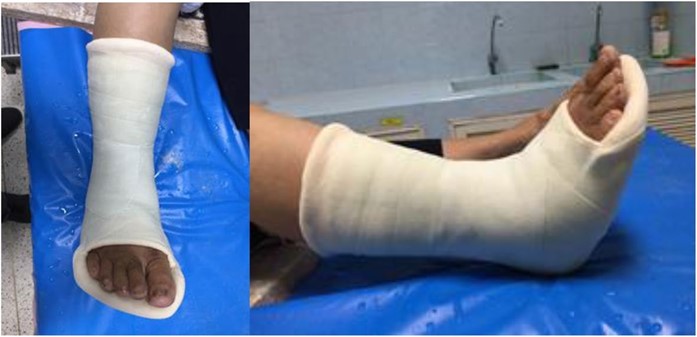A client with a compound fracture of the left ankle is being discharged with a below-the-knee cast. Which
instruction should the practical nurse (PN) provide to the client prior to discharge?
Apply a cold pack to any "hot spots" on the cast.
Keep the left leg in a dependent position.
Expect some increase in pain.
Never scratch under the cast.
The Correct Answer is D
When providing instructions to a client with a below-the-knee cast for a compound fracture of the left ankle, it is important to prioritize their safety and proper care of the cast. The instruction to never scratch under the cast is crucial for preventing complications and maintaining the integrity of the cast.
Let's evaluate the other options:
a) Apply a cold pack to any "hot spots" on the cast.
Applying a cold pack to any "hot spots" on the cast may help alleviate discomfort or itching, but it is not the highest priority instruction. Preventing scratching under the cast is more important to avoid skin damage or infection.
b) Keep the left leg in a dependent position.
Keeping the left leg in a dependent position (hanging down) is not the appropriate instruction for a client with a below-the-knee cast. It is generally recommended to elevate the injured limb to reduce swelling and promote proper blood flow. Elevating the leg would involve keeping it raised above the level of the heart.
c) Expect some increase in pain.
While it is possible for the client to experience some increase in pain after the application of a cast, this instruction alone is not comprehensive or specific enough for proper discharge education. Providing information about pain management strategies or when to seek medical atention for excessive pain would be more appropriate.
In summary, when discharging a client with a compound fracture of the left ankle and a below-the-knee cast, the practical nurse (PN) should provide the instruction to never scratch under the cast. This helps prevent complications and maintain the integrity of the cast, promoting proper healing of the fracture.

Nursing Test Bank
Naxlex Comprehensive Predictor Exams
Related Questions
Correct Answer is A
Explanation
Choice A reason: Giving the patient extra time to perform activities is an appropriate action by the nurse because it respects the patient's autonomy and dignity, and reduces frustration and anxiety. Bradykinesia is a condition of slow movement that affects people with Parkinson's disease due to decreased dopamine levels in the brain.
Choice B reason: Teaching the client to walk more quickly when ambulating is not an appropriate action by the nurse because it can increase the risk of falls and injuries, and worsen the patient's symptoms. Bradykinesia can impair the patient's balance, coordination, and gait, making it difficult to initiate and maintain movement.
Choice C reason: Placing the client on a low-protein, low-calorie diet is not an appropriate action by the nurse because it can lead to malnutrition, weight loss, and muscle wasting, which can further compromise the patient's health and function. Bradykinesia does not affect the patient's metabolism or nutritional needs.
Choice D reason: Completing passive range-of-motion exercises daily is not an appropriate action by the nurse because it does not address the underlying cause of bradykinesia, which is reduced dopamine production in the brain. Passive range-of-motion exercises are movements performed by another person without the patient's active participation, which can decrease the patient's motivation and self-efficacy.
Correct Answer is B
Explanation
Choice A reason: Fluconazole (Diflucan) is not a medication that community members exposed to anthrax will need access to because it is an antifungal drug that treats fungal infections, not bacterial infections. Anthrax is caused by Bacillus anthracis, a gram-positive spore-forming bacterium.
Choice B reason: Ciprofloxacin (Cipro) is a medication that community members exposed to anthrax will need access to because it is an antibiotic drug that treats bacterial infections, including anthrax. Ciprofloxacin is one of the recommended drugs for post-exposure prophylaxis and treatment of anthrax by the Centers for Disease Control and Prevention (CDC).
Choice C reason: Varenicline (Chantix) is not a medication that community members exposed to anthrax will need access to because it is a smoking cessation drug that helps people quit smoking, not treat infections. Varenicline has no effect on anthrax.
Choice D reason: Potassium iodide (KI) is not a medication that community members exposed to anthrax will need access to because it is a thyroid-blocking agent that protects against radioactive iodine exposure, not bacterial exposurE. Potassium iodide is used in case of nuclear accidents or attacks, not bioterrorism attacks involving anthrax.
Whether you are a student looking to ace your exams or a practicing nurse seeking to enhance your expertise , our nursing education contents will empower you with the confidence and competence to make a difference in the lives of patients and become a respected leader in the healthcare field.
Visit Naxlex, invest in your future and unlock endless possibilities with our unparalleled nursing education contents today
Report Wrong Answer on the Current Question
Do you disagree with the answer? If yes, what is your expected answer? Explain.
Kindly be descriptive with the issue you are facing.
